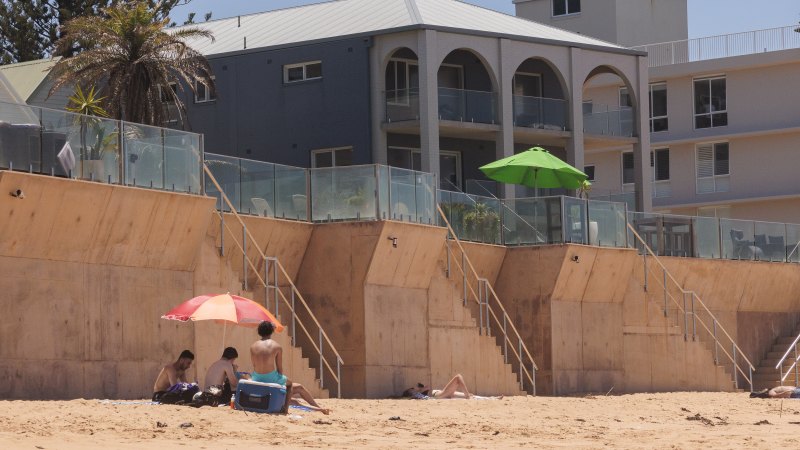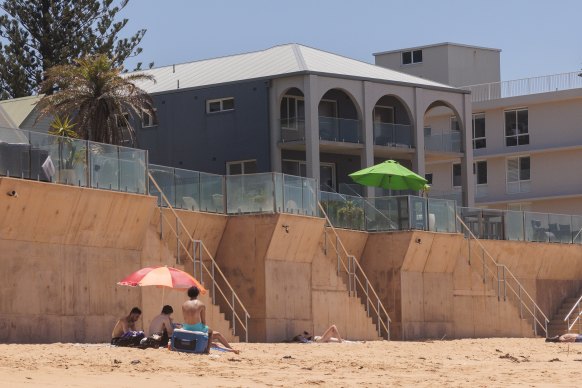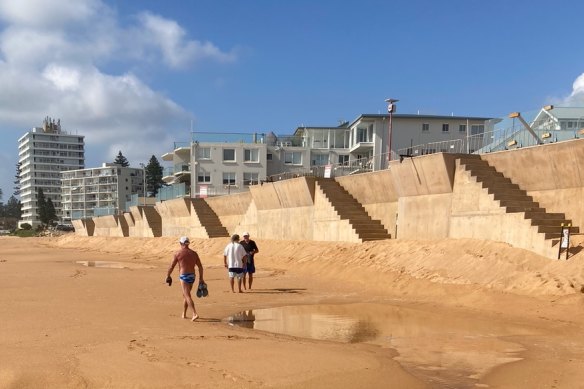Save articles for later
Add articles to your saved list and come back to them any time.
It would be easy to regard the stoush over the building of the giant vertical seawall on Collaroy-Narrabeen beach as a local issue – a conflict between seafront property owners, assorted greenies and ratbag surfers; one of little importance to our wider coast.
Easy to think so, but it would be a mistake. Erosion wrought by sea-level rise and destructive weather systems turbocharged by climate change will inevitably bring home the complex issues of coastal protection to many of our beloved beaches.
Largely unnoticed, approval was granted for an extension of the controversial Collaroy seawall further north in late September, after more than 170 submissions in protest triggered a hearing with a Northern Beaches Council-nominated Local Planning Panel (LPP). Inexplicably, expertise in coastal management is not seen as an essential for a LPP.
The seawall at Collaroy is to be extended despite significant opposition from local residents.Credit: Brook Mitchell
We are a state which prides itself on our magnificent stretches of fine sand and rolling surf. It’s where we flock to in summer, and where so many of us build our homes for a better view. We are woefully unprepared for the future, and often ignorant of what’s at stake.
The time to think about the fate of our coast is now. We urgently need a co-ordinated, informed response to what’s ahead. Instead, we have our heads buried in the proverbial sand and are facing a raft of ad-hoc solutions administered by local councils which lack the required expertise in their efforts to turn back the tides.
It’s not all their fault. Our state government has, over successive years, abrogated responsibility for what happens along our coast. There is no oversight or accountability.
With the approval (and now extension), by Northern Beaches Council, of the towering, ugly seawall at Collaroy-Narrabeen to protect private property – a 7.5 metre-high concrete edifice, piered 10 metres below into the sand – a precedent has been set. It is no exaggeration to say that such a wall could be coming to a beach near you. The seaside community at Wamberal on the Central Coast is bracing for a similar proposal.
A beach is a dynamic system. It needs room to breathe. When vertical seawalls are built on narrow beaches, they reflect and concentrate wave energy, accelerating erosion. This is what science tells us. It’s plain old physics.
A vertical seawall signs a death warrant for a beach. Even though seasonal weather patterns may accrete or deplete sand in the short term, eventually the sand disappears, and the beach becomes extinct. A diving board from a private property into deep water is what the future looks like.
The “towering, ugly” seawall at Collaroy-Narrabeen is to be extended, despite opposition from local residents.
There are solutions. Rock revetment (sloping) walls buried under the beach; sand nourishment and strategic buy-back of threatened properties should all be considered. Such revetment walls are deployed on the Gold Coast. Sand nourishment is used around the world. Why not here, you ask?
Under the former NSW Coastal Protection Act of 1979, any proposed works would be automatically referred to a Coastal Panel – made up of geomorphologists, engineering and environmental experts. Under the Coastal Management Act of 2016, there is no compulsion to refer to such an informed body. We now have a Coastal Council for “advice”, should the planning minister choose to consult it.
One of the authors of the most recent act is coastal engineer Angus Gordon. He says the legislation has been “scuppered”. As an international coastal zone expert recognised by the UN, a former general manager of Pittwater Council (now amalgamated with Northern Beaches) and as someone who has studied Collaroy-Narrabeen beach for decades, he is blunt in his assessment of the vertical seawall.
“This is a throwback to 19th century brutalist engineering. That beach will not be there for future generations. What has been built is clearly in breach of the act.”
At the heart of it, he says, is a risk-adverse culture in the state’s planning department. “Our government has washed its hands of the issue. Too hard.” The devolution of decision-making is an “unmitigated disaster”, he adds.
Reports the Northern Beaches Council relied upon to approve the construction of the seawall are “flawed”, Gordon asserts. Even when advised the proposed wall did not consider the effects of climate change, “the Council decided to overlook that”.
For the record, the 2016 Coastal Management Act has as its first principle: “(a) to protect and enhance natural coastal processes and coastal environmental values including natural character, scenic value, biological diversity and ecosystem integrity and resilience…”. It further requires consideration of climate change, visual impact and more.
The act is just so much “blah blah”, as local councils now interpret their own Coastal Zone Management Plan (CZMP) with as much or little community input as they deem adequate. In the case of Wamberal, where the council is under administration, no consultation at all on their CZMP, say local protestors.
There are three things NSW Planning Minister Paul Scully must do immediately: declare a moratorium on the building of any new seawalls; reinstate the Coastal Panel with expertise, and teeth, to assess the design and effect of proposed protections; and appoint a Coastal Commissioner to oversee the lot. (We have a building commish – so why not the same for our non-built assets? Our precious beaches?)
Until then, we can expect more battles between private interest and public amenity: councils approving development through opaque processes and in thrall to special interests, the broader community of beachgoers blindsided.
Those of us who love our beaches, our kids, and theirs after them, will all lose.
Wendy Harmer is a broadcaster, author and stage performer. She has been a Collaroy resident for 30 years.
Get to the heart of what’s happening with climate change and the environment. Sign up for our fortnightly Environment newsletter.
correction
The NSW planning minister’s name is Paul Scully, not Carl Scully as originally published.
Most Viewed in National
From our partners
Source: Read Full Article



